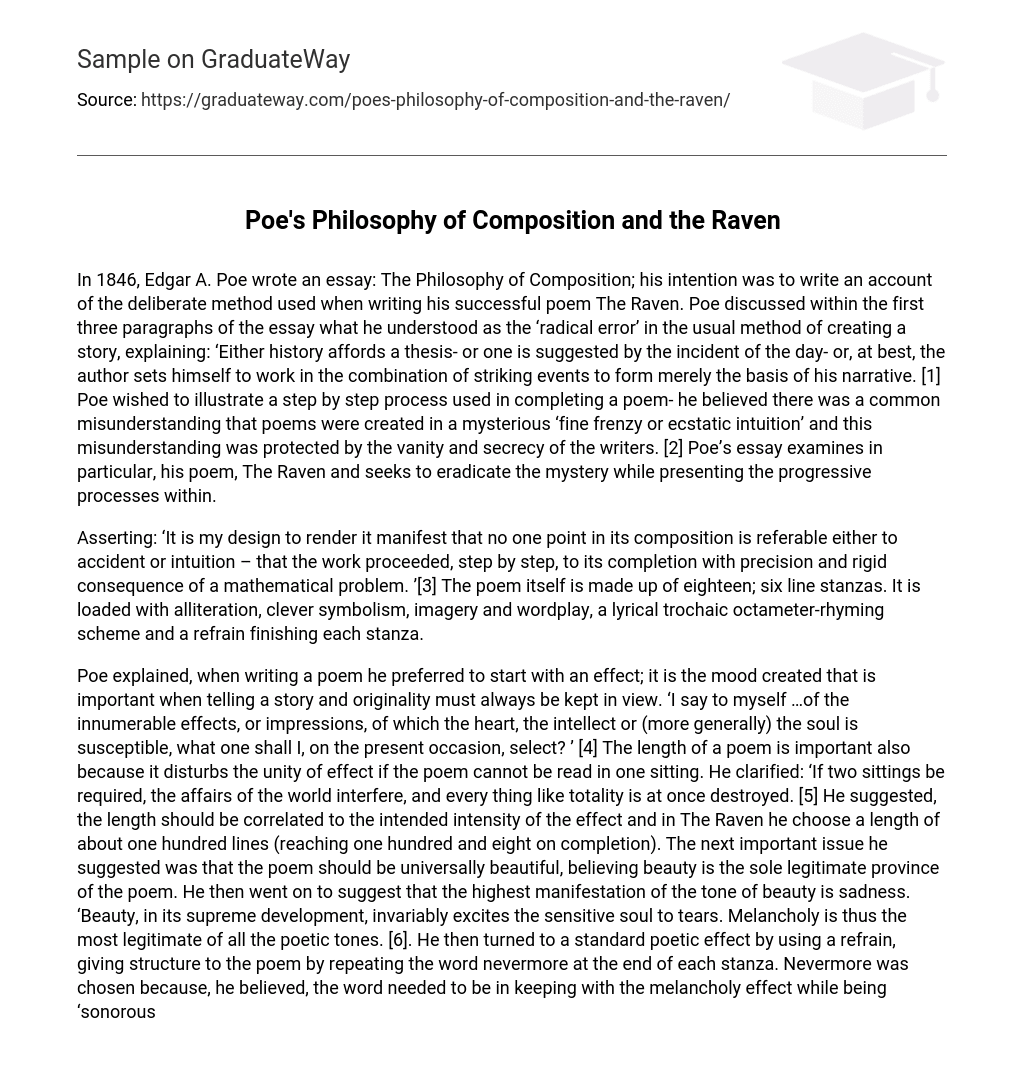In 1846, Edgar A. Poe wrote The Philosophy of Composition, an essay in which he aimed to provide insight into the deliberate method he employed while writing his successful poem, The Raven. Within the first three paragraphs of the essay, Poe criticized the conventional approach to storytelling, labeling it a ‘radical error.’ He explained that authors either derived their themes from historical events or current incidents, or simply combined striking events to form the foundation of their narrative. [1] Poe wanted to demonstrate a step-by-step process for composing a poem, as he believed there was a commonly held misconception that poems were created through some sort of mystical ‘fine frenzy or ecstatic intuition.’ He suggested that this misunderstanding was perpetuated by writers’ own vanity and secrecy. [2] In his essay, Poe specifically analyzes his poem, The Raven, aiming to dispel its mystery and reveal the progressive processes involved in its creation.
The author is asserting that every aspect of the poem’s composition was deliberate and planned, with no elements left to chance. The poem consists of eighteen six-line stanzas, and features alliteration, symbolism, imagery, wordplay, and a musical rhythm. Each stanza is structured in a specific meter and rhyme scheme, with a refrain at the end.
Poe stated that when writing a poem, he preferred to start with an effect. The mood created is important in telling a story and originality should always be considered. He asked himself, out of the many effects or impressions that the heart, intellect, or soul can experience, which one should he select for the current occasion? The length of a poem is also important because it disrupts the unity of effect if it cannot be read in one sitting. If it requires two sittings, worldly affairs interfere and the totality is immediately destroyed. Poe suggested that the length should be correlated to the intended intensity of the effect. In “The Raven,” he chose a length of about one hundred lines, eventually reaching one hundred and eight upon completion. Another important aspect Poe addressed was that the poem should be universally beautiful as he believed beauty is the only legitimate domain of poetry. Furthermore, he argued that the highest expression of beauty is sadness. According to him, beauty in its supreme development always evokes tears from a sensitive soul. Therefore, melancholy is the most legitimate tone for poetry. He then employed a standard poetic effect by using a refrain, incorporating structure into the poem by repeating the word “nevermore” at the end of each stanza.Nevermore was selected because it was believed that the word should align with the melancholy effect while possessing a melodious and extendable emphasis. The letter ‘O’ was considered the most melodious vowel, while ‘R’ was deemed the most pronounceable consonant. Initially, a parrot was contemplated as the voice for the repetition of the word nevermore, as it harmonized with its repetitive nature.
However, Edgar Allan Poe decided to use a raven as the mouthpiece in order to create a melancholy effect and convey language effectively. He believed that the death of a beautiful woman was the most poetic theme and that the lips of a bereaved lover were best suited to express this topic. Poe explained that the end of the poem was also the beginning and he aimed to establish a climax, the most poignant effect, before building up to this point. He composed a stanza to determine this climax and to better vary and graduate the seriousness and importance of the preceding queries of the lover. Additionally, he wanted to settle the rhythm, metre, and length of the poem, as well as gradually develop the stanzas leading up to it so that none of them would surpass this rhythmical effect. In conclusion, “The Raven” is a meticulously constructed poem with careful attention given to every detail. While it tells a haunting story of descent into madness, its rich language, rhyming, and meter make it a delightful linguistic treat and a poetic masterpiece.
Floyd Stovall suggests: ‘The Raven was the product of conscious effort by a healthy and alert intelligence.’[10]
Bibliography
• Poe, Edgar. A, The Philosophy of Composition, Society of Baltimore
• Poe, Edgar. A, The Raven
• Stovall, Floyd, The Conscious Art of Edgar Allan Poe, College English, Vol. 24, no 6, pp. 417-21.
[1] Edgar A. Poe, The Philosophy of Composition, Edgar Allan Poe, Society of Baltimore, [accessed: 25. march. 2013.]
[2] The Philosophy of Composition.
[3] The Philosophy of Composition.
[4] The Philosophy of Composition.
[5] The Philosophy of Composition.
[6] The philosophy of Composition.
[7] The philosophy of Composition.
[8] The Philosophy of Composition.
[9] The Philosophy of Composition.
[10] Floyd Stovall, The conscious Art of Edgar Allan Poe, College English, Vol. 24, no 6, p. 421., [accessed:7. april. 2013.]





